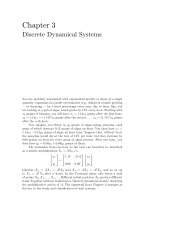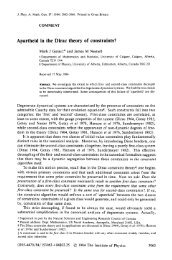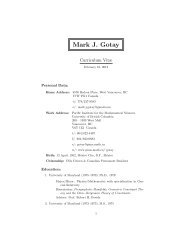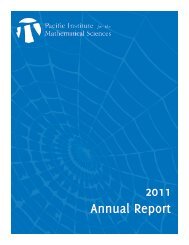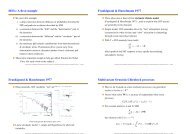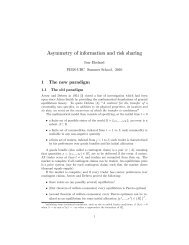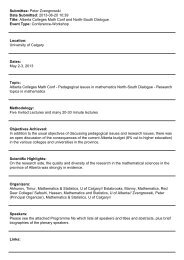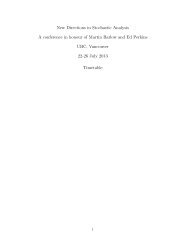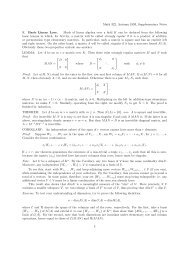55 PRIMA 2013 AbstractsEfficient numerical method for boundary conditionsof kinetic equ<strong>at</strong>ionsChang YangUniversité Claude Bernard Lyon 1, Franceyang@m<strong>at</strong>h.univ-lyon1.frIn this talk we present a new algorithm based on Cartesianmesh for the numerical approxim<strong>at</strong>ion of the kineticmodels on complex geometry boundary. Due to the highdimensional property, numerical algorithms based on unstructuredmeshes for a complex geometry are not appropri<strong>at</strong>e.Here we propose to adapt the inverse Lax-Wendroff procedure, which was recently introduced forconserv<strong>at</strong>ion laws [1], to the kinetic equ<strong>at</strong>ions. We firstapply this algorithm for Boltzmann type oper<strong>at</strong>ors (BGK,ES-BGK models) in 1D × 3D and 2D × 3D [2]. Then weextend a similar method to bacterial chemotaxis models[3], which is a coupling problem of kinetic equ<strong>at</strong>ionand parabolic equ<strong>at</strong>ion. Numerical results illustr<strong>at</strong>e theaccuracy properties of these algorithms.[1] S. Tan and C.-W. Shu, Inverse Lax-Wendroff procedurefor numerical boundary conditions of conserv<strong>at</strong>ionlaws, Journal of Comput<strong>at</strong>ional Physics, 229 (2010),8144-8166.[2] F. Filbet and C. Yang, Inverse Lax-Wendroff methodfor boundary conditions of Boltzmann equ<strong>at</strong>ions, Journalof Comput<strong>at</strong>ional Physics, accepted.[3] F. Filbet and C. Yang, Numerical Simul<strong>at</strong>ions of KineticModels for chemotaxis, submitted.MD simul<strong>at</strong>ions for motions of evapor<strong>at</strong>ivedroplets driven by thermal gradientsCongmin WuXiamen University, Chinacmwu@xmu.edu.cnThe driving mechanism of fluid transport <strong>at</strong> nanoscaleis one of the key problems on the design of micro- andnanofluidic devices. We performed molecular dynamicssimul<strong>at</strong>ions to study the motions of evapor<strong>at</strong>ive dropletsdriven by thermal gradients along nanochannels. The effectof droplet size and the effect of the co-existent fluidtemper<strong>at</strong>ure on the motions of droplets are investig<strong>at</strong>ed.Our simul<strong>at</strong>ion results are in semi-quantit<strong>at</strong>ive agreementwith the prediction of the continuum model (Xu and Qian2012 Phys. Rev. E 85 061603). It is found th<strong>at</strong> thedroplet mobility is inversely proportional to a dimensionlesscoefficient associ<strong>at</strong>ed with the total r<strong>at</strong>e of dissip<strong>at</strong>iondue to droplet movement. Our results show th<strong>at</strong> this coefficientis of order unity and increases with the dropletsize for the small droplets (∼ 10nm). Through a theoreticalanalysis on the size of the thermal singularity, itcan be shown th<strong>at</strong> the droplet mobility decreases with decreasingcoexistence temper<strong>at</strong>ure. This is also observedin our MD simul<strong>at</strong>ions.This is a joint work with Xinpeng Xu and Tiezheng Qianfrom HKUST.Calcul<strong>at</strong>ing areas and volumes with rot<strong>at</strong>edaxisPablo Zafra, Christopher FloresKean University, USApzafra@kean.edufloresc1@kean.eduFinding areas under a curve and volumes of solid of revolutionsare standard applic<strong>at</strong>ions of definite integrals ina Calculus class. Conventional examples in calculus textbooksuse the regular Cartesian coordin<strong>at</strong>e system withvertical and horizontal axes. We explore in this researchthe problem of calcul<strong>at</strong>ing areas and volumes when theaxis is rot<strong>at</strong>ed, and use basic tools from geometry andlinear algebra to formul<strong>at</strong>e the corresponding definite integrals.We present some insights as well as difficultiesencountered in setting-up the integrals, and in evalu<strong>at</strong>ingthem analytically or numerically using graphing calcul<strong>at</strong>orsor online m<strong>at</strong>h tools.Inversion of geothermal he<strong>at</strong> flux in a thermomechanicallycoupled Stokes ice sheet modelHongyu Zhu, Noemi Petra, Georg Stadler, Toby Isaac,Omar Gh<strong>at</strong>tas, Thomas J.R. HughesUniversity of Texas <strong>at</strong> Austin, USAzhuhongyu@ices.utexas.eduModeling the dynamics of polar ice sheets is critical forprojection of future sea level rise. Yet, there remainlarge uncertainties in the basal boundary conditions (e.g.,geothermal he<strong>at</strong> flux) of the ice sheet. Here we targetthe inversion of the basal geothermal he<strong>at</strong> flux using surfacevelocity measurements. The flow of ice sheets andglaciers is modeled as a sheer thinning, viscous incompressiblefluid with temper<strong>at</strong>ure-dependent viscosity viaa thermomechanically coupled Stokes model. The inverseproblem is formul<strong>at</strong>ed as a nonlinear least-squares optimiz<strong>at</strong>ionproblem with a cost functional th<strong>at</strong> contains themisfit between surface velocity observ<strong>at</strong>ions and modelpredictions and a Tikhonov regulariz<strong>at</strong>ion term to renderthe problem well-posed. We use an adjoint-basedinexact Newton method for the solution of this leastsquares optimiz<strong>at</strong>ion problem. Results for 2-D and 3-Dmodel problems demonstr<strong>at</strong>e the ability of inverting for asmoothly varying geothermal he<strong>at</strong> flux in cold ice regions.This capability will be incorpor<strong>at</strong>ed into a st<strong>at</strong>e-of-the-artcontinental-scale ice sheet dynamics model.Modelling of temper<strong>at</strong>ure and pricingwe<strong>at</strong>her deriv<strong>at</strong>ives: a comparison formainland ChinaManuela Ender, Lu ZongXi’an Jiaotong-Liverpool University, Chinamanuela.ender@xjtlu.edu.cnTemper<strong>at</strong>ure-based we<strong>at</strong>her deriv<strong>at</strong>ives are a promisingfinancial instrument to hedge we<strong>at</strong>her risk. In most m<strong>at</strong>urefinancial markets of the world, we<strong>at</strong>her deriv<strong>at</strong>ivesare traded for several years now. However in MainlandChina, such a market does not exist yet. To make thelaunch of such instruments possible, multi-regional researchis needed to find the most suitable temper<strong>at</strong>uremodel for Mainland China. The contribution of this paperis to compare the performance of several up-to-d<strong>at</strong>etemper<strong>at</strong>ure models to d<strong>at</strong>a from twelve cities from allclim<strong>at</strong>ic zones in China. The models are compared interms of fitting the daily average temper<strong>at</strong>ure, normalityof residuals, simul<strong>at</strong>ion errors and model risk whenused for pricing futures and options. The comparison includesa model with monthly contant vol<strong>at</strong>ility (Al<strong>at</strong>onet al, 2002), with daily vol<strong>at</strong>ility (Benth et al, 2007), amodel with stochastic vol<strong>at</strong>ility like proposed by Benthand Benth (2011) and a model using a Spline approachfor surface modelling similar to Schiller et al (2012). Thisis the first paper on multi-regional temper<strong>at</strong>ure modellingand we<strong>at</strong>her deriv<strong>at</strong>ives pricing using such a large numberof cities in a comparison of different models in MainlandChina.Contributed Talks Group 5Differential Equ<strong>at</strong>ionsNonlinear impulsive differential equ<strong>at</strong>ionsarising from chemotherapeutic tre<strong>at</strong>ment
56 PRIMA 2013 AbstractsBaili ChenGustavus Adolphus College, USAbchen@gustavus.eduWe prove the existence of periodic solutions of systemsof nonlinear impulsive differential equ<strong>at</strong>ions arising fromchemotherapeutic tre<strong>at</strong>ment for cancer. Our analysis isbased on Mawhin’s continu<strong>at</strong>ion theorem of coincidencedegree theorem.Analysis of some nonlinear PDEs from multiscalegeophysical applic<strong>at</strong>ionsBin ChengUniversity of Surrey, UKb.cheng@surrey.ac.ukThis talk is regarding PDE systems from geophysical applic<strong>at</strong>ionswith multiple time scales, in which linear skewself-adjointoper<strong>at</strong>ors of size 1/epsilon gives rise to highlyoscill<strong>at</strong>ory solutions. Analysis is performed in justifyingthe limiting dynamics as epsilon goes to zero; furthermore,the analysis yields estim<strong>at</strong>es on the difference betweenthe multiscale solution and the limiting solution.We will introduce a simple yet effective time-averagingtechnique which is especially useful in general domainswhere Fourier analysis is not applicable.Some piston problems in fluid dynamicsMin DingShanghai Jiao Tong University, Chinaminding@sjtu.edu.cnThe piston problem is analyzed from the m<strong>at</strong>hem<strong>at</strong>icalpoint of view. Some fe<strong>at</strong>ures and phenomena caused bythe motion of the piston are revealed. We discuss somepiston problems for both classical Euler equ<strong>at</strong>ions andrel<strong>at</strong>ivistic Euler equ<strong>at</strong>ions of compressible fluids. In particular,we focus on strong shock front solutions.Over-compressive shock profile associ<strong>at</strong>edwith a simplified system from MHDLinglong DuN<strong>at</strong>ional University of Singapore, Singaporeg0901229@nus.edu.sgIn this talk, we present the wave propag<strong>at</strong>ion around anover-compressive shock profile with large amplitude for asimplified system from MHD, which is a rot<strong>at</strong>ionally invariantsystem of viscous conserv<strong>at</strong>ion laws. We showth<strong>at</strong> the solution converges pointwise to another overcompressiveprofile exponentially, when the perturb<strong>at</strong>ionsof the initial d<strong>at</strong>a to a given profile are sufficiently small.We also give the explicit structure of the solution forthe linearized system. The approach begins with an extractionof non-decaying component stacked <strong>at</strong> the shockfront, followed by an iter<strong>at</strong>ed approxim<strong>at</strong>ion process forthe remainder. This sharp estim<strong>at</strong>e is strong enough tostudy the nonlinear problem and conclude the stability ofprofile.This is a joint work with Professor Shih-Hsien Yu.Global stability of E-H type regular refractionof shocks on the interface between two mediaBeixiang FangShanghai Jiao Tong University, Chinabxfang@sjtu.edu.cnIn this talk I will discuss the refraction of shocks on theinterface for 2-d steady compressible flow. Particularly,the class of E-H type regular refraction is defined and itsglobal stability of the wave structure is verified. The 2-dsteady potential flow equ<strong>at</strong>ions is employed to describethe motion of the fluid. The stability problem of the E-Htype regular refraction can be reduced to a free boundaryproblem of nonlinear mixed type equ<strong>at</strong>ions in an unboundeddomain. The corresponding linearized problemhas similarities to a generalized Tricomi problem of thelinear Lavrentiev-Bitsadze mixed type equ<strong>at</strong>ion, and itcan be reduced to a nonlocal boundary value problemof an elliptic system. The l<strong>at</strong>ter is finally solved by establishingthe bijection of the corresponding nonlocal oper<strong>at</strong>orin a weighted Hölder space via careful harmonicanalysis.This is a joint work with CHEN Shuxing and HU Dian.Multiplicity of positive solutions for a p-q-Laplacian equ<strong>at</strong>ion with critical nonlinearitiesTsing-San HsuChang Gung University, Taiwan R.O.C.tshsu@mail.cgu.edu.twIn this talk, we study the effect of the coefficient f(x)of the critical nonlinearity on the number of positive solutionsfor a p-q-Laplacian equ<strong>at</strong>ion. Under suitable assumptionsfor f(x) and g(x), we should prove th<strong>at</strong> forsufficiently small λ > 0, there exist <strong>at</strong> least k positivesolutions of the following p-q-Laplacian equ<strong>at</strong>ion−∆ pu−∆ qu=f(x)|u| p∗ −2 u+λg(x)|u| r−2 u in Ω,u = 0 on ∂Ω,where Ω ⊂ R N is a bounded smooth domain, N > p,1 < q < N(p−1) < p ≤ max{p, p N−1 ∗ − qp−1 } < r < p∗ ,p ∗ =Np is the critical Sobolev exponent and ∆su =N−pdiv(|∇u| s−2 ∇u) is the s-Laplacian of u.The linear hyperbolic initial boundary valueproblems in a domain with cornersAimin HuangIndiana University, USAaimhuang@indiana.eduIn this article, we consider linear hyperbolic InitialBoundary Value Problems (IBVP) in a rectangle in boththe constant and variable coefficients cases. We use semigroupmethod instead of Fourier analysis to achieve thewell-posedness of the linear hyperbolic system, and wefind by diagonaliz<strong>at</strong>ion th<strong>at</strong> there are only two simplemodes in the system which we call hyperbolic and ellipticmodes. The hyperbolic system in consider<strong>at</strong>ion is eithersymmetric or Friedrichs-symmetrizable.On quasilinear elliptic equ<strong>at</strong>ions with variableexponentsYun-Ho KimSangmyung University, Koreakyh1213@smu.ac.krWe study the following elliptic equ<strong>at</strong>ions with variableexponents−div(φ(x, |∇u|)∇u) = λf(x, u)in Ωwhich is subject to Dirichlet boundary condition. Undersuitable conditions on φ and f, employing the vari<strong>at</strong>ionalmethods, in particular, mountain pass theorem
- Page 2 and 3:
1PRIMA 2013-Table of ContentsTable
- Page 4 and 5:
3PRIMA 2013-OrganizationOrganizatio
- Page 6 and 7:
5PRIMA 2013-OrganizationYoshikazu G
- Page 8 and 9:
7PRIMA 2013-Useful InformationUsefu
- Page 10 and 11:
9PRIMA 2013-Useful InformationTaxi:
- Page 12 and 13:
11PRIMA 2013-Useful Informationmath
- Page 14 and 15:
13PRIMA 2013 Program-Schedule-at-a-
- Page 16 and 17:
15PRIMA 2013 Program-Monday, June 2
- Page 18 and 19:
17PRIMA 2013 Program-Monday, June 2
- Page 20 and 21:
19PRIMA 2013 Program-Monday, June 2
- Page 22 and 23:
21PRIMA 2013 Program-Monday, June 2
- Page 24 and 25:
23PRIMA 2013 Program-Tuesday, June
- Page 26 and 27:
25PRIMA 2013 Program-Tuesday, June
- Page 29 and 30:
28PRIMA 2013 Program-Tuesday, June
- Page 31 and 32:
30PRIMA 2013 Program-Tuesday, June
- Page 33 and 34:
32PRIMA 2013 Program-Wednesday, Jun
- Page 35 and 36:
34PRIMA 2013 Program- Thursday, Jun
- Page 37 and 38:
36PRIMA 2013 Program- Thursday, Jun
- Page 39 and 40:
38PRIMA 2013 Program- Thursday, Jun
- Page 41 and 42:
40PRIMA 2013 Program- Thursday, Jun
- Page 43 and 44:
42PRIMA 2013 Program- Friday, June
- Page 45 and 46:
44PRIMA 2013 Program- Friday, June
- Page 48 and 49:
1 PRIMA 2013 AbstractsContents1 Pub
- Page 50 and 51:
3 PRIMA 2013 Abstractsof subfactors
- Page 52 and 53: 5 PRIMA 2013 AbstractsprocessesXu S
- Page 54 and 55: 7 PRIMA 2013 AbstractsIn this talk
- Page 56 and 57: 9 PRIMA 2013 Abstractsindependently
- Page 58 and 59: 11 PRIMA 2013 AbstractsEnumerating,
- Page 60 and 61: 13 PRIMA 2013 AbstractsRyuhei Uehar
- Page 62 and 63: 15 PRIMA 2013 AbstractsIn this talk
- Page 64 and 65: 17 PRIMA 2013 AbstractsSpecial Sess
- Page 66 and 67: 19 PRIMA 2013 Abstractscritical slo
- Page 68 and 69: 21 PRIMA 2013 AbstractsSpecial Sess
- Page 70 and 71: 23 PRIMA 2013 Abstractsstrictly awa
- Page 72 and 73: 25 PRIMA 2013 AbstractsPedram Hekma
- Page 74 and 75: 27 PRIMA 2013 Abstractsis well-know
- Page 76 and 77: 29 PRIMA 2013 Abstractssolid substr
- Page 78 and 79: 31 PRIMA 2013 AbstractsRapoport-Zin
- Page 80 and 81: 33 PRIMA 2013 Abstractssense. Our a
- Page 82 and 83: 35 PRIMA 2013 AbstractsIn an econom
- Page 84 and 85: 37 PRIMA 2013 AbstractsKyoto Univer
- Page 86 and 87: 39 PRIMA 2013 AbstractsAlexander Mo
- Page 88 and 89: 41 PRIMA 2013 AbstractsOsamu SaekiK
- Page 90 and 91: 43 PRIMA 2013 Abstractsopen Delzant
- Page 92 and 93: 45 PRIMA 2013 AbstractsJian ZhouTsi
- Page 94 and 95: 47 PRIMA 2013 AbstractsJiaqun WeiNa
- Page 96 and 97: 49 PRIMA 2013 Abstractsthe end of 2
- Page 98 and 99: 51 PRIMA 2013 AbstractsJongyook Par
- Page 100 and 101: 53 PRIMA 2013 AbstractsPancyclicity
- Page 104 and 105: 57 PRIMA 2013 Abstractsand fountain
- Page 106: 59 PRIMA 2013 Abstractsformula esti



